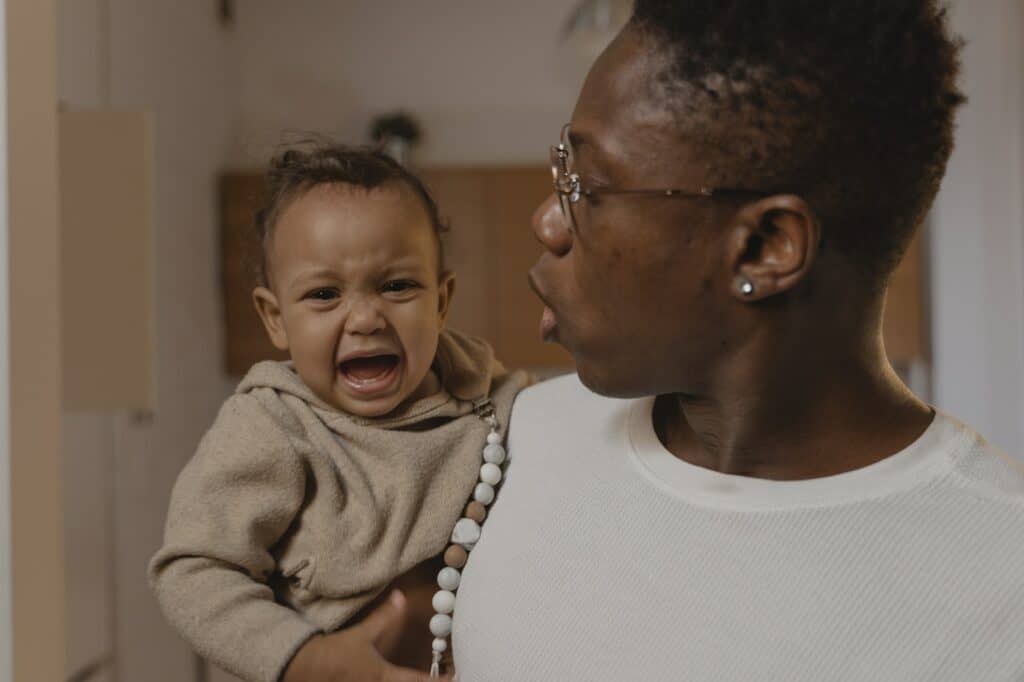Temper tantrums are a common occurrence in children, particularly in those aged between two and four years old. While they can be frustrating for parents to deal with, they are a normal part of a child’s development and usually decrease in frequency and intensity as the child grows older. However, some parents may notice that their 3 year old temper tantrums getting worse instead of improving.
It is important for parents to understand that temper tantrums are a normal part of a child’s emotional development. They are usually a result of the child’s inability to express their emotions effectively. However, severe tantrums that involve physical aggression, self-injury, or destruction of property may be a cause for concern. In such cases, it is important to seek professional help.
Key Takeaways:
- Temper tantrums are a normal part of a child’s emotional development.
- Severe tantrums that involve physical aggression, self-injury, or destruction of property may be a cause for concern and require professional help.
- Parents should remain patient and calm during tantrums and provide a safe and supportive environment for their child.
Understanding Temper Tantrums
What Are Temper Tantrums
Temper tantrums are a common behavior in toddlers and young children. They are outbursts of frustration and anger that can happen when a child is unable to express their emotions or desires. These tantrums can involve crying, screaming, kicking, and other disruptive behaviors.
Temper tantrums are a normal part of a child’s development and are not necessarily a sign of a more serious problem. However, if they become frequent and severe, they may indicate an underlying issue that needs to be addressed.
Why Do Toddlers Throw Tantrums
There are many reasons why toddlers may throw tantrums. Some common triggers include:
- Frustration: Toddlers may become frustrated when they are unable to do something or get what they want.
- Hunger or fatigue: Hungry or tired toddlers may be more prone to temper tantrums.
- Overstimulation: Too much noise or activity can overwhelm young children and lead to tantrums.
- Changes in routine: Toddlers thrive on routine and may become upset when their schedule is disrupted.
- Seeking attention: Some toddlers may throw tantrums as a way to get attention from their parents or caregivers.
It is important to remember that tantrums are a normal part of a child’s development and should be handled calmly and consistently. Parents can help prevent tantrums by setting clear boundaries and routines, providing plenty of positive attention, and offering choices whenever possible.
Signs of Severe Tantrums
When it comes to toddler tantrums, it is important to distinguish between typical behavior and more severe tantrums. Severe tantrums can be characterized by extreme physical and emotional responses, as well as prolonged episodes of screaming, hitting, kicking, and crying.

Physical Indications
Severe tantrums can be physically exhausting for both the child and caregiver. During a severe tantrum, a child may exhibit the following physical signs:
- Flailing arms and legs
- Rapid heart rate and breathing
- Sweating
- Redness in the face
- Clenched fists or teeth
- Loss of control of bodily functions (i.e. urinating or defecating)
If a child exhibits these physical symptoms during a tantrum, it is important to ensure their safety by removing any objects that could cause harm.
Emotional Signs
In addition to physical symptoms, severe tantrums can also be characterized by intense emotional responses. These emotional responses may include:
- Extreme anger or frustration
- Feelings of helplessness or hopelessness
- Intense sadness or fear
- Difficulty calming down or regulating emotions
It is important to note that severe tantrums are not always caused by specific triggers or events. In some cases, they may be a sign of an underlying condition such as anxiety or ADHD.
Overall, it is important to recognize the signs of severe tantrums and seek support if necessary. Caregivers can try to prevent tantrums by establishing routines, setting clear boundaries and consequences, and providing positive reinforcement for good behavior. However, if severe tantrums persist, it may be necessary to seek guidance from a healthcare professional.
Common Triggers of Tantrums
Temper tantrums are a common occurrence in young children, but when they start to become more frequent and intense, it can be concerning for parents. While there are many factors that can contribute to a tantrum, there are some common triggers that parents should be aware of.
1. Transitional Moments
One of the most common triggers of tantrums is during transitional moments. This can include things like leaving the house, going to bed, or switching activities. Young children often struggle with transitions and can become upset when they have to stop doing something they enjoy or move on to something new. To help prevent tantrums during these times, parents can try to provide warnings ahead of time and give their child a chance to mentally prepare for the change.
2. Hunger and Tiredness
Another common trigger of tantrums is hunger and tiredness. Young children have small stomachs and need frequent meals and snacks to keep their energy levels up. When they become hungry or tired, they can become irritable and more prone to tantrums. Parents should try to keep their child on a regular eating and sleeping schedule to prevent these triggers.
3. Public Settings
Public settings can also be a trigger for tantrums. Young children can become overwhelmed by the noise and activity level in public places, leading to tantrums. Parents can try to minimize these triggers by avoiding overly stimulating environments and bringing along comforting items, such as a favorite toy or blanket.
By being aware of these common triggers, parents can better understand their child’s behavior and take steps to prevent tantrums before they occur.
How to Respond to Tantrums
When dealing with a child’s tantrum, it is important to respond in a way that is both effective and calm. In this section, we will discuss some strategies for responding to tantrums in a productive manner.

1. Staying Calm
One of the most important things to remember when dealing with a tantrum is to stay calm. If the parent or caregiver becomes upset or angry, this can escalate the situation and make it more difficult to resolve. Taking a deep breath and remaining calm can help to de-escalate the situation and allow for more effective communication.
2. Ignoring Negative Behaviors
It is important to avoid reinforcing negative behaviors during a tantrum. This means not giving in to the child’s demands or engaging in arguments or negotiations. Instead, the parent or caregiver should ignore negative behaviors and focus on positive behaviors. This can help to reinforce positive behaviors and discourage negative behaviors in the future.
3. Communicating Effectively
When communicating with a child during a tantrum, it is important to use clear and concise language. The parent or caregiver should avoid using negative language or criticism, and instead focus on positive reinforcement and problem-solving. Using a calm and neutral tone of voice can also help to de-escalate the situation and encourage effective communication.
In summary, responding to tantrums requires a calm and effective approach. Strategies such as staying calm, ignoring negative behaviors, and communicating effectively can help to de-escalate the situation and encourage positive behaviors in the future.
Preventing Temper Tantrums
Temper tantrums are a common occurrence in children, especially in the toddler years. However, if left unchecked, these tantrums can escalate and become more frequent. Here are some ways that parents and caregivers can prevent temper tantrums in three-year-olds.
Establishing Routine
One of the most effective ways to prevent temper tantrums is to establish a routine. Children thrive on predictability and knowing what to expect. Having a consistent daily routine can help reduce stress and anxiety in children, which in turn can reduce the likelihood of temper tantrums. Parents and caregivers can create a daily schedule that includes regular meal times, nap times, and playtime. This schedule should be followed as closely as possible, with minor adjustments made as necessary.
Positive Reinforcement
Another way to prevent temper tantrums is to use positive reinforcement. Praising children for good behavior can be more effective than punishing them for bad behavior. Parents and caregivers can use verbal praise, hugs, or small rewards to encourage positive behavior. For example, if a child shares a toy with a sibling, the parent can praise the child and offer a small reward, such as a sticker or a piece of candy. This positive reinforcement can help children feel good about themselves and encourage them to continue good behavior.
Effective Use of Warnings
Finally, parents and caregivers can prevent temper tantrums by using warnings effectively. Giving children warnings before transitioning from one activity to another can help them prepare mentally and emotionally. For example, if a child is playing with toys and it is almost time to leave for daycare, the parent can give a warning by saying, “In five minutes, we need to get ready to leave.” This warning can help the child mentally prepare for the upcoming transition and reduce the likelihood of a temper tantrum.
In conclusion, preventing temper tantrums in three-year-olds requires a combination of establishing routine, positive reinforcement, and effective use of warnings. By following these strategies, parents and caregivers can help reduce stress and anxiety in children and promote positive behavior.
When to Seek Professional Help
If a child’s temper tantrums are getting worse and interfering with their daily life, it may be time to seek professional help. There are two types of professionals that can be consulted: a pediatrician or a psychologist.

Consulting a Pediatrician
A pediatrician can rule out any underlying medical issues that may be causing the child’s tantrums. They can also provide guidance on how to manage the child’s behavior and may refer the child to a specialist if necessary.
During the appointment, the pediatrician may ask questions about the child’s behavior, such as how often the tantrums occur and what triggers them. They may also ask about the child’s diet, sleep patterns, and overall health.
Seeing a Psychologist
If the pediatrician rules out any medical issues, a psychologist may be consulted. A psychologist can evaluate the child’s behavior and provide guidance on how to manage it. They can also work with the child and family to develop strategies for coping with the tantrums.
During the evaluation, the psychologist may ask questions about the child’s behavior and may also observe the child in various settings. They may also ask about the family’s history and dynamics.
It is important to seek professional help if a child’s temper tantrums are getting worse and interfering with their daily life. A pediatrician or psychologist can provide guidance and support for both the child and family.
Parenting Techniques and Mistakes
When it comes to dealing with temper tantrums in 3-year-olds, it’s important for parents to have effective techniques in place. However, there are also common mistakes that parents can make that may exacerbate the situation.

Using Time-outs Effectively
One technique that has been shown to be effective in dealing with temper tantrums is the use of time-outs. This involves removing the child from the situation and placing them in a designated area, such as a corner or a chair, for a set amount of time. The idea behind this technique is to give the child time to calm down and reflect on their behavior.
It’s important for parents to use time-outs effectively. This means setting clear rules and expectations for the child, such as explaining what behavior will result in a time-out and how long the time-out will last. It’s also important to remain calm and consistent when enforcing time-outs. Parents should avoid engaging with the child during the time-out and should only end the time-out when the child has calmed down.
Avoiding Bribes and Threats
While it may be tempting to resort to bribes or threats to stop a temper tantrum, this can actually make the situation worse. Bribes, such as promising the child a treat or toy if they stop crying, can reinforce the behavior and teach the child that throwing a tantrum is an effective way to get what they want.
Threats, such as telling the child they will be punished if they don’t stop crying, can also be counterproductive. This can make the child feel even more upset and may escalate the situation.
Instead of bribes or threats, parents should focus on using positive reinforcement to encourage good behavior. This can include praising the child when they behave well or offering small rewards for good behavior.
Overall, effective parenting techniques for dealing with temper tantrums in 3-year-olds involve setting clear rules and expectations, remaining calm and consistent, and avoiding bribes and threats. By using these techniques, parents can help their child learn to regulate their emotions and behavior in a healthy way.
Additional Resources and References
Parents and caregivers who are struggling to manage their child’s temper tantrums may find it helpful to seek additional resources and references. Here are a few options to consider:
References
- American Academy of Pediatrics. (2018). Temper tantrums. HealthyChildren.org. https://www.healthychildren.org/English/ages-stages/toddler/Pages/Temper-Tantrums.aspx
- National Institute of Mental Health. (2019). Disruptive mood dysregulation disorder. https://www.nimh.nih.gov/health/topics/disruptive-mood-dysregulation-disorder-dmdd/index.shtml
- Zero to Three. (n.d.). Tantrums. https://www.zerotothree.org/resources/128-tantrums
These references provide information on the causes of temper tantrums, how to prevent them, and strategies for managing them when they occur. The American Academy of Pediatrics and Zero to Three websites also offer tips for promoting positive behavior and healthy child development.
Resources
- The Incredible Years. (n.d.). Parenting programs. https://incredibleyears.com/programs/parent/
- Positive Parenting Program. (n.d.). Triple P. https://www.triplep-parenting.com/
- Child Mind Institute. (n.d.). Parent resources. https://childmind.org/our-impact/for-families/
These resources offer evidence-based parenting programs and support for parents and caregivers. The Incredible Years and Triple P programs focus on teaching parents positive parenting strategies and building strong parent-child relationships. The Child Mind Institute provides a range of resources for parents, including articles on child development and mental health, as well as a directory of mental health professionals and treatment centers.
It is important to note that temper tantrums are a normal part of child development and can be managed with patience and consistency. However, if a child’s tantrums are severe, frequent, or interfering with their daily life, it may be helpful to seek guidance from a healthcare provider or mental health professional.
Frequently Asked Questions
How can I handle my 3 year old’s tantrums?
Handling a 3 year old’s tantrums can be challenging, but it’s important to remain calm and patient. It’s important to set clear boundaries and consequences for unacceptable behavior. Distraction and redirection can also be effective techniques to diffuse a tantrum.
When should I be concerned about my toddler’s temper tantrums?
If your toddler’s tantrums are frequent, intense, and last for an extended period of time, it may be a cause for concern. Additionally, if your toddler is causing harm to themselves or others during a tantrum, it’s important to seek professional help.
What are some effective ways to calm an angry 3-year-old?
Taking deep breaths, counting to ten, and using positive affirmations can help calm an angry 3-year-old. It’s also important to validate their feelings and provide a safe and calm environment for them to express themselves.
Why are my 3 year old’s tantrums getting worse?
There can be many reasons why a 3 year old’s tantrums are getting worse, including frustration with their lack of communication skills, changes in routine, and feeling overwhelmed. It’s important to identify the root cause of the tantrums and address them accordingly.
What are some tips for dealing with middle of the night tantrums in a 3 year old?
It’s important to remain calm and reassuring during a middle of the night tantrum. Comforting your child and providing a safe and calm environment can help them feel secure and reduce the likelihood of future tantrums.
Is it normal for a 3 year old to have daily tantrums?
While tantrums are normal for 3 year olds, having daily tantrums may be a cause for concern. It’s important to identify the root cause of the tantrums and address them accordingly. Seeking professional help may also be necessary.

Iesha is a loving mother of 2 beautiful children. She’s an active parent who enjoys indoor and outdoor adventures with her family. Her mission is to share practical and realistic parenting advice to help the parenting community becoming stronger.
